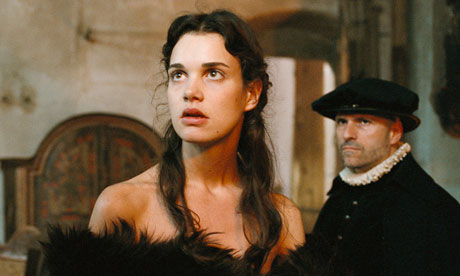As a major exhibition on the enigmatic queen attracts the crowds in Edinburgh, three movies are set to explore her life

'A modern woman, passionate and fragile': Camille Rutherford as Mary in Thomas Imbach's film.
Since 1971 film-makers have tried to emulate the Oscar-winning success of Mary, Queen of Scots, starring Vanessa Redgrave and Glenda Jackson as the tragic Scottish queen and her nemesis, Elizabeth I. Aborted later attempts include one by Hollywood's actress-producer Scarlett Johansson and British director Alexander Mackendrick.
Two UK productions are still at early stages, but a Swiss film-maker has beaten them to it with a sympathetic psychological portrait set to be an art-house hit. Zurich-based Thomas Imbach has directed, produced and co-written the film, with Camille Rutherford playing Mary, which has been singled out for this season's festivals at Locarno and Toronto.
More than 400 years after she was executed by Elizabeth, the Protestant Queen of England, Mary Stuart remains the most enigmatic royal in Britain's history. Imbach said he has tried to represent her as "neither a saintly heroine motivated by Catholicism nor ambitious queen obsessed with power, but as a modern woman, passionate and fragile". The film is based on Austrian novelist Stefan Zweig's 1935 biography, Mary Stuart, a long-term bestseller in Germany and France but out of print in the UK and the US for decades until 2010.
Other forthcoming films include one by Eric Fellner and Tim Bevan, the team behind hits including Notting Hill. Irish actress Saorsie Ronan is reportedly cast in the title role. The production will be directed by Oscar-winning Danish film-maker Susanne Bier. The co-scriptwriter, Michael Hirst, collaborated on the Oscar-winning Elizabeth, starring Cate Blanchett as the Virgin Queen.
David Forsyth, senior curator at National Museums Scotland, whose exhibition on Mary is drawing record crowds, said: "In Britain, she's divisive. Mary continues to have her supporters and detractors who take up quite polar positions. Because there are important episodes where the historical evidence is deliberately tampered with, missing or lost, people can weave their own narratives. In Europe she's seen as possibly a Catholic martyr."
The great-granddaughter of Henry VII, Mary was born in Scotland and grew up at the French court. After the death of her French husband, Francis II, she returned to Scotland, ruling for seven years. Her marriage to Lord Darnley, with whom she had a child (the future James VI of Scotland and James I of England), ended with his murder.
She then married the Earl of Bothwell, who was accused of involvement in Darnley's death. She fled to England but, feared as a Catholic threat to the throne, she was eventually declared guilty of treason and beheaded in 1587.
Imbach said his film stuck as closely to the facts as possible: "A lot of [her life] is still controversial. Was she involved in the murder of her husband? Historians still have their battles on this. As a spectator, you can make your choices."
He said part of the difficulty of the project lay in the complexity of her story, "so dense, with so many layers". In the UK, Mary is still controversial, "very much in the shadow of Elizabeth and not quite respectable even today", while in more Catholic European countries she is seen as "a heroine".
"In German language countries, she is well known through the work of Friedrich Schiller, whose play is often staged and read by every schoolchild," added Imbach. The exhibition at National Museums Scotland, a few hundred yards from the scene of Darnley's murder, has attracted more than 25,000 visitors since it opened in June. Forsyth t lold the Observer: "There's an abiding interest in Mary, and there seems to be no letup." In the museum's bookshop and at the Edinburgh book festival, critically acclaimed works on Mary have been selling "like hot cakes". They include the museum's own study, Rosalind Marshall's In My End Is My Beginning, and Linda Porter's Crown of Thistles.
Forsyth said Mary's story shows human beings at their best and worst.The exhibition presents Mary as enigmatic, leaving open whether she was betrayed or was an adulteress with her husband's blood on her hands. "We wanted to re-establish her as a vital, living queen," said Forsyth.
• This article was amended on 19 August 2013. An earlier version said that Stefan Zweig's book on Mary Stuart was out of print. This has been corrected.
No comments:
Post a Comment